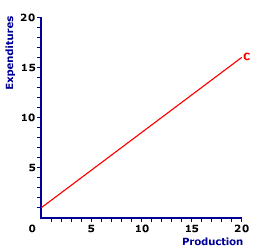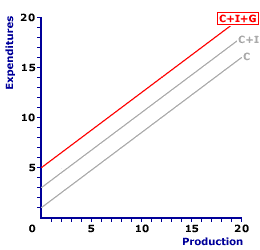
|
|
ACTIVIST POLICY: Government policies that involve explicit actions designed to achieve specific goals. A common type of activist policy is that designed to stabilize business cycles, reduce unemployment, and lower inflation, through government spending and taxes (fiscal policy) or the money supply (monetary policy). Activist policies are also term discretionary policies because they involve discretionary decisions by government. A contrast to activist policy is automatic stabilizers that help stabilize business cycles without explicit government actions.
Visit the GLOSS*arama
|
|


|

|
                           THREE-SECTOR AGGREGATE EXPENDITURES LINE: A graphical depiction of the relation between aggregate expenditures by the three domestic macroeconomic sectors (household, business, and government) and the level of aggregate income or production. The three-sector aggregate expenditures line combines consumption expenditures, investment expenditures, and government purchases. The slope of this aggregate expenditures line is based on the marginal propensity to consume, adjusted for marginal propensities of the other expenditures that are assumed to be induced when constructing the line. This is one of three aggregate expenditures lines based on the number of sectors included. The others are the two-sector aggregate expenditures line and the four-sector aggregate expenditures line. The aggregate expenditures line, which embodies the key Keynesian principle of effective demand, shows the relation between aggregate expenditures and the actual level of aggregate income or production in the domestic economy. The income and production measures commonly used are national income and gross domestic product. A three-sector aggregate expenditures line combines the expenditures of all three domestic macroeconomic sectors--household sector, business sector, and government sector.The three-sector aggregate expenditures line forms the foundation of the standard three-sector Keynesian model. The three-sector Keynesian model combines the three-sector aggregate expenditures line with the 45-degree line to determine the equilibrium level of income and production. The three-sector Keynesian model captures all of the essential ingredients of Keynesian economics. Consumption expenditures contain the basic induce expenditure relation through the marginal propensity to consume that is so important to Keynesian economics. Autonomous investment expenditures provide the primary source of business-cycle instability. And government purchases then offer the key Keynesian fiscal policy tool for addressing business cycle problems. This three-sector aggregate expenditures line is commonly designated with a symbolic equation representing the three expenditures included in the line. where: AE is aggregate expenditures, C is consumption expenditures, I is investment expenditures, and G is government purchases.Three SectorsA good place to begin with the three-sector aggregate expenditures line is the three sectors that provide expenditures included in the line. These are the three domestic macroeconomic sectors--household sector, business sector, and government sector. The foreign sector is not included.- Household Sector: This sector includes the entire, wants-and-needs-satisfying, eating, breathing, consuming population of the economy. In a word, it includes everyone, all consumers, all people, and every member of society. Pollyanna Pumpernickel, a hypothetical hardworking mother of two, is a representative member of the household sector. So too is Winston Smythe Kennsington III, a hypothetical affluent corporate executive.
- Business Sector: This sector contains the private, profit-seeking firms in the economy that combine scarce resources into the production of wants-and-needs satisfying goods and services. It includes proprietorships, partnerships, and corporations. OmniConglomerate, Inc., a hypothetical multi-billion dollar, multi-national, mega corporation, exemplifies a member of the business sector. However, Manny Mustard, a hypothetical proprietor who owns and operates a little sandwich shop is also part of the business sector.
- Government Sector: This sector includes all government entities that impose resource allocation decisions, that might not be made otherwise, on the rest of the economy. It consists of the three primary levels of federal, state, and local government responsible for passing and enforcing laws. Of course, all branches and agencies of the U.S. Federal Government--Congress, Department of Transportation, Environmental Protection Agency, etc.--is part of the government sector. So too is the hypothetical Shady Valley City Council and the hypothetical local Shady Valley Board of Education included in the government sector.
Three ExpendituresThe aggregate expenditures line is the combination of expenditures by the three domestic macroeconomic sectors--household, business, and government. Each of these three sectors is responsible for a specific expenditure on gross domestic product--consumption, investment, and government purchases. And each expenditure is represented by a corresponding expenditure line.| Consumption Line |  | Investment Line |  | Government Purchases Line |  |
The exhibit to the right presents the linear relations for each of the three aggregate expenditures.- Consumption Expenditures: The largest of the three expenditures on gross domestic product is consumption expenditures by the household sector. These expenditures are used to purchase everything from apple juice to cubic zirconium, essentially all of the goods and services that people purchase to satisfy wants and needs. The consumption line is the relation between these consumption expenditures and aggregate income or production. A representative consumption line, labeled C, is presented in the top panel of the exhibit to the right. This red line is positively sloped due to the Keynesian psychological law and the slope is measured by the marginal propensity to consume (MPC). The intercept is autonomous consumption.
- Investment Expenditures: The least stable of the three expenditures on gross domestic product is investment expenditures by the business sector. These are expenditures on capital goods, ranging from million-dollar factories to fifty-cent screw drivers. Investment expenditures are for fixed structures, equipment, and inventories (working capital). The relation between investment expenditures and aggregate income or production is illustrated by an investment line. Two alternative investment lines are presented in the second panel of the exhibit to the right. The horizontal gray line, labeled I, indicates autonomous investment, investment that is unaffected by income or production. The positively-sloped red line, labeled I', is induced investment, investment that is affected by income or production, and is measured by the marginal propensity to invest (MPI).
- Government Purchases: A key fiscal policy tool used to stabilize business cycles is government purchases on gross domestic product by the government sector. These are expenditures on goods and services used for a wide range of government activities, ranging from military aircraft to paper clips, and includes expenditures by federal, state, and local governments. It includes both capital goods as well as consumption goods. The relation between government purchases and aggregate income or production is illustrated by a government purchases line. Two alternative government purchases lines are presented in the third panel of the exhibit to the right. The horizontal gray line, labeled G, indicates autonomous government purchases, government purchases that are unaffected by income or production. The positively-sloped red line, labeled G', is induced government purchases, government purchases that are affected by income or production, and is measured by the marginal propensity for government purchases (MPG).
The Three-Sector LineThree-Sector
Aggregate Expenditures Line |  |
A representative three-sector aggregate expenditures line is presented in the exhibit to the right. This red line, labeled C+I+G in the exhibit is positively sloped, indicating that greater levels of income and production generate greater aggregate expenditures by the three domestic macroeconomic sectors. This positive relation reflects the Keynesian economics principle of effective demand--more income means more expenditures.Also included in this exhibit are two gray lines, labeled C and C+I. These two lines represent the sequential stacking of expenditures by the three sectors, beginning with consumption (C), then adding investment (C+I), then ending with government purchases for the three-sector aggregate expenditures line (C+I+G). This particular three-sector aggregate expenditures line assumes that all expenditures, other than consumption, are completely autonomous. This is why all three lines in the exhibit are parallel. The C+I line is parallel to the C line because investment is autonomous and constant at all levels of income and production. The same can be said about the C+I+G and the C+I lines with respect to autonomous government purchases. Because consumption is the only induced expenditure, which is measured by the marginal propensity to consume, the slopes of all three parallel lines are also equal to the marginal propensity to consume. If any of the expenditures are assumed to be induced, then the slopes of the lines will change accordingly, becoming steeper if induced investment or government purchases are included. Two More LinesThe aggregate expenditures line actually comes in several varieties, depending on how many of the three expenditures are included and whether or not the expenditures are assumed to be induced or autonomous. The three most common aggregate expenditures lines represent the sequential inclusion of the three expenditures, beginning with consumption expenditures and investment expenditures, then adding government purchases and net exports.- Two Sectors: The simplest aggregate expenditures line is based on expenditures by the two "private" sectors--household and business. This two-sector aggregate expenditures line is the combination of consumption expenditures and investment expenditures. More often than not, this line is based on autonomous investment. This two-sector line captures the essential elements of Keynesian economics and thus is often used as an introductory presentation. One important element captured in this line is, first and foremost, induced consumption and the psychological law. Another element is the equilibrium equality between production and expenditures and the potential instability created by changes in autonomous investment.
- Four Sectors: The complete expenditures line is constructed by adding net exports to the three-sector line. This four-sector aggregate expenditures line is the combination of consumption expenditures, investment expenditures, government purchases, and net exports. While the assorted expenditures can be assumed autonomous, as the "complete" aggregate expenditures line, anything that is realistically induced by income and production is generally assumed to be induced in the construction of this line.

Recommended Citation:THREE-SECTOR AGGREGATE EXPENDITURES LINE, AmosWEB Encyclonomic WEB*pedia, http://www.AmosWEB.com, AmosWEB LLC, 2000-2025. [Accessed: July 18, 2025].
Check Out These Related Terms... | | | | | | | | | |
Or For A Little Background... | | | | | | | | | | | | | | | | | |
And For Further Study... | | | | | | | | | | | | | |
Search Again?
Back to the WEB*pedia
|



|

|
RED AGGRESSERINE
[What's This?]
Today, you are likely to spend a great deal of time at a flea market wanting to buy either a weathervane with a cow on top or a box of multi-colored, plastic paper clips. Be on the lookout for telephone calls from long-lost relatives.
Your Complete Scope
This isn't me! What am I?
|

|
|
The first "Black Friday" on record, a friday marked by a major financial catastrophe, occurred on September 24, 1869 -- A FRIDAY -- when an attempted cornering of the gold market induced a financial crises and economy-wide depression.
|

|
|
"A winner is someone who recognizes his God-given talents, works his tail off to develop them into skills, and uses those skills to accomplish his goals. " -- Larry Bird, basketball player
|

|
NBER
National Bureau of Economic Research
|

|
|
Tell us what you think about AmosWEB. Like what you see? Have suggestions for improvements? Let us know. Click the User Feedback link.
User Feedback
|


|


